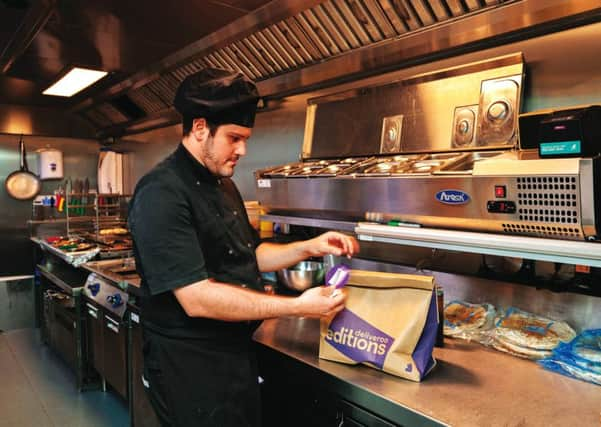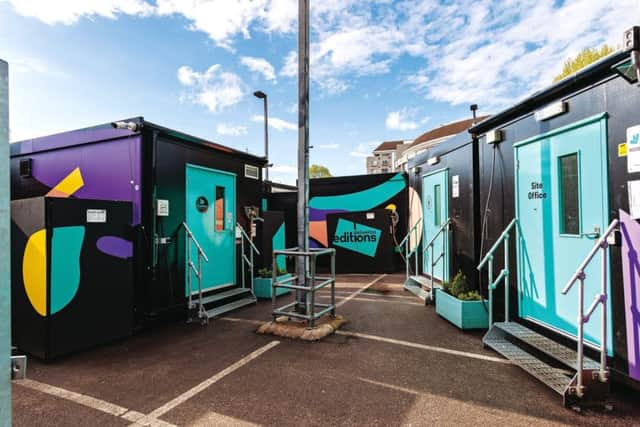Vision Scotland: Appetite for disruption


In the last few years the casual dining market has changed, with more of us eating in restaurants far more often.
This has been coupled with a huge rise in bricks and mortar city restaurants offering to bring their hot food to the customer’s door – eating out while staying in – facilitated by home delivery firms providing an online app and a network of couriers.
Advertisement
Hide AdAdvertisement
Hide AdGlobal information company NPD Group’s figures show that over the past decade the takeaway delivery market has grown from £2.4 billion to £4.2bn.


Deliveroo, Just Eat, Hungryhouse and UberEats have been the catalyst for this growth, with their infrastructure and easy-to-use apps allowing smaller independent food providers to compete more effectively with the bigger food service chains.
NPD believes takeaway deliveries – the public’s favourites being Chinese, pizza, burgers and curry, in that order – will grow over the next two years to be worth £5bn.
But this rise in delivery food could be a concept that has passed you by if you don’t live in a city.
Serving just as a platform, these companies own no restaurants and cook no food.
The order placed online with a platform company is passed to the individual restaurant, the food is picked up by a courier and around 25 per cent of the order goes to the platform.
However, bricks and mortar restaurants may lack the kitchen space needed to expand to meet demand for delivery, and this is where dark kitchens can make a difference.
Fulfilling takeaway orders from an expensive city centre location isn’t particularly cost-effective either.
Advertisement
Hide AdAdvertisement
Hide AdCooking meals elsewhere for delivery therefore makes sense, but many customers who order a high-end dish from a sophisticated city centre eatery might not realise that it is being sped to them from an industrial estate.
Whether or not that matters to customers, it does make financial sense. Dark kitchens are a way for restaurants to pool resources, reduce overheads and increase capacity.
These kitchens don’t have to be in high value commercial areas as they are not reliant on footfall or being in a prestigious dining out hotspot, such as St Andrew Square in Edinburgh and St Vincent Street in Glasgow.
Instead, they can be located in much cheaper areas on the edge of town, for instance, and consist of little more than a basic space with a kitchen fit-out.
What is interesting is that the biggest driving force behind dark kitchens is Deliveroo, which was previously restricted to coordinating the orders.
In cities around the world, basic industrial kitchens, branded as Deliveroo Editions but known as a Rooboxes, have been set up by Deliveroo in some pretty unglamorous areas. They house individual restaurants’ staff to cook orders from their own menus, so the food the customer gets from a Roobox should taste like it was cooked in the original restaurant.
It is a concept that has yet to reach Scotland but there are a handful of sites across London. Another has opened recently in Brighton and the concept is being trialled in Singapore, Hong Kong, Melbourne and Dubai.
Roland Smyth, head of Scottish hotels and leisure group at law firm CMS, says that the establishment of dark kitchens has positive implications for the restaurant sector.
Advertisement
Hide AdAdvertisement
Hide Ad“It is quick and low-cost to set up, you don’t have expensive rent and rates, waiting staff, chairs and tables or cutlery, and those savings can be passed on to the customer.”
He says of the effect the rise in delivery options has on the market is about growth of the whole, rather than direct competition.
“I see it as a complementary service to restaurants as people will still want the social experience of eating out in the same way VHS, DVDs and online streaming haven’t killed cinema.
“It is unlocking a different market.”
But he says the establishment of dark kitchens has implications beyond saving money by moving delivery meals out of sit-down restaurants’ kitchens.
“Eventually dark kitchens might be located in areas that do not have access to a selection of brands.
“It doesn’t have to be high-end brands. Working with data on demographics and footfall, local authorities can analyse which types of food offering are lacking in which areas and, if they find a gap in the market, encourage, for instance, a pizza delivery company brand franchisee to open.”
Smyth says the use of low-cost units as outposts of established brands is destined to come to Scotland at some point and could fill the gap in areas that aren’t covered by hot food delivery at all.
“If you open the Deliveroo app outside a major city or town, often there is little or nothing available, but with inexpensive Rooboxes set up in a small town, Deliveroo could deliver big brand hot food to those who can’t get it now.”
The concept offers huge advantages for restaurants too.
Advertisement
Hide AdAdvertisement
Hide AdSmyth says: “It can help start-ups trial their concepts. Deliveroo will let restaurateurs go into a Roobox for as little as a week so they can test the market with a new product.
“There is also huge potential for helping with growth. There is the idea that the most difficult restaurant to open is the third one. When you get to three restaurants it means your brand is becoming established, you have proof of concept and you can start to unlock bank funding and private equity, but it can also be challenging moving from two to three.
“We have clients who, instead of opening a third restaurant, have taken space in a dark kitchen and used that as their proof of concept for funding purposes. It is like a half-step to expansion.”
Tom Whittington, director of retail and leisure research at Savills, agrees that dark kitchens present an opportunity across the UK.
“They allow Deliveroo to go into markets where there isn’t a critical mass of restaurants and that is quite important to smaller locations.
“For many people outside cities, the local Chinese will deliver, but there will be no other choice.”
Whittington sees the advantages for city restaurants to move their delivery cooking offsite too.
“A lot of operators are having to rethink their model. Those who hadn’t thought about delivery are now finding a lot of their business comes from that and it has its own drawbacks.
Advertisement
Hide AdAdvertisement
Hide Ad“There’s complexity around trying to fit delivery orders from a traditional restaurant which may not have the configuration in their kitchens to cope with the added capacity. They might not even have space outside where a courier can pull up on a moped.”
But for all the advantages of Deliveroo’s new concept, some in the industry are asking questions about the power that the company wields. It holds a huge database of customers and it has been said that the company limits what it feeds back to its customers, the restaurants.
Market watchers say this could be laying the groundwork for a move from providing the platform, and now the kitchens, to entering the lucrative market of providing the food.
Whittington says: “If you look at any of the disruptors, such as Amazon, they will always be looking at ways to increase their market share.
“But what makes Deliveroo work are the brands behind it. The strength is that it is responding to customer demand and it may bring types of food [to areas] where other restaurants aren’t interested in being.
“It is an enabler as well as a disruptor and has enabled brands to access a market which they would not otherwise have access to.”
And he says that, while Deliveroo is in a seemingly strong position to capitalise, the technology is always evolving so other companies will be wanting their share.
“There are two things going on. One is value – an industrial unit is always going to be cheaper than a property in the high street and so that changes the price point.
Advertisement
Hide AdAdvertisement
Hide Ad“But the second one is about demographics. Over the last ten years the British consumer is adapting and the type of people who live in London, young professionals with a good income – their culture is all about restaurant food, whether eating out or in.
“The dark kitchen concept hasn’t really made it outside London, but if it is proved to work then it might well do.”
This article featured in the Autumn 2018 edition of Vision Scotland. A digital version can be found here.